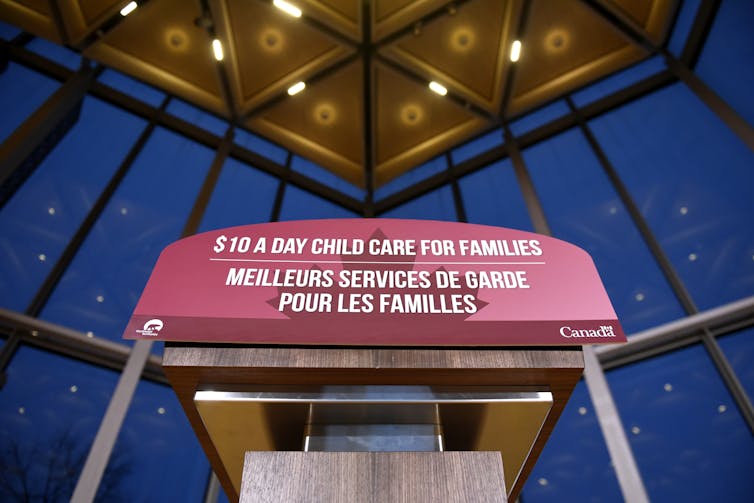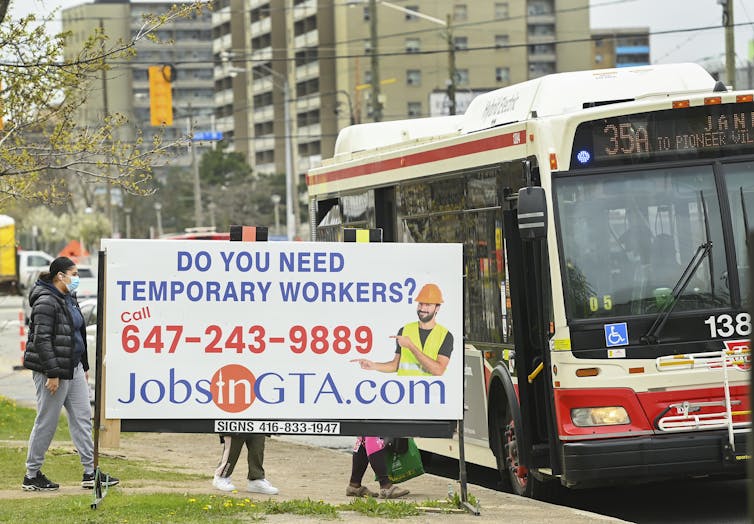
Petr Varmuza, University of Toronto; Linda A. White, University of Toronto, and Michal Perlman, University of Toronto
Many parents, economists and and child-care advocates celebrated the signing of Ontario’s early learning and child-care agreement with the federal government at the end of March.
The agreement means a substantial infusion of federal government funding to allow an immediate 25 per cent reduction of child-care fees, followed by a further reduction to 50 per cent at the end of 2022. A final reduction to an average of $10 per day is set to happen by 2026.
As researchers with combined expertise in public policy and its effectiveness, and applied psychology and human development and preschool-aged children, we believe universal access to early learning and child care should mean an equitable treatment of every child, where every child receives the support they need. But this isn’t the case with Ontario’s agreement.
Something that deserves scrutiny and redress is how Ontario’s new early learning and child-care deal creates inequities for children in the most economically disadvantaged families.
Issues with the agreement
Only a few days after Ontario’s agreement was signed, significant cracks began to emerge. Child-care researchers and advocates raised concerns about the agreement’s provisions that allow proportional expansion of the for-profit sector and the lack of commitment to living wages and benefits for child-care workers.
The proposed expansion of 86,000 spaces beyond the 2019 licensed capacity falls overwhelmingly short of the forecasted demand that will be generated by lower child-care fees.
Expert analysis suggests that as many as 200,000 additional licensed child-care spaces may be required as a result of demand spurred by halving parents’ child-care fees. By 2026, when the full fee reduction must be implemented, yet another 100,000 spaces may be required.
Every unique early learning and child-care agreement Canada has signed across the country leaves it up to provinces or territories to determine how the average $10 fee will achieved.

Subsidy rules
In Ontario, the agreement provides for the $10 provincial average to be created by the combination of a flat $12 fee combined with lower fees paid by families receiving child care subsidies. Those subsidies are subject to availability and aren’t guaranteed to every family who meets established social need criteria. Criteria include being employed, attending school or having a certified child or parent with a special need.
These conditions are reminiscent of Victorian-era attitudes that obscure the policy and systemic roots of poverty and which restrict state aid for the “deserving” poor — those who are considered gainfully employed, “productive” or working to improve their economic situations.
In Ontario, the amount of the financial subsidy is the difference between full fees and a family’s own contribution as determined by an income test defined by provincial regulation. The payment is calculated by excluding net taxable family income under $20,000, charging a 10 per cent of income between $20,000 and $40,000 and rising to 30 per cent for income above $40,000.
If a parent’s child-care provider agrees to participate in Ontario’s new early learning and child care agreement, 25 per cent fees parents have paid after April 1, 2022, would be retroactively refunded. The new rate would apply going forward. Providers have up to Sept. 1 to sign up.
For fully employed families, whether they pay full fees or receive a subsidy, the child-care cost may be further reduced by claiming the Child Care Expense Deduction and the Ontario Childcare and Affordable Relief from Expense tax credit.
Access isn’t universal
Ontario’s agreement thus creates a universal, flat-fee child care for medium and high-income families. Subject to limited funding availability, Ontario retains subsidized child-care for a portion of the subsidy eligible parents for low-income people under stringent conditions.
Higher-income families have no eligibility requirements or a maximum income cap to take advantage of the reduced child-care fees.
But for those low-income families who meet the subsidy eligibility criteria, access will become unfortunately harder: Ontario’s April 2022 provincial funding guidelines reduce transfers to municipalities for subsidy funding by 25 per cent. They also specifically prohibit the use of the new early learning and care agreement funding from increasing the number of subsidies, despite long waiting lists in many areas of Ontario.

Many low-income families won’t be eligible
Decades of research demonstrates that the most disadvantaged children can benefit most from access to high-quality licensed child care.
The very tool that can improve the life chances and reduce the inter-generational transfer of poverty is, by the Ontario government’s exclusionary policy, systemically less available to many of the most disadvantaged children.
There is substantial international and Canadian evidence that well-off families living in well-off communities have better access to better-quality child-care programs. Without attention to equitable access, universalization of child-care access leads to over-representation of children from relatively more affluent families. This can be seen in Québec’s experience with implementing what was launched as $5-a-day child care more than 20 years ago, as well as in the experience of several European Union member states.
Universal access should mean an equitable treatment of every child, where every child receives the support they need.

Next steps
In Ontario, the obvious next steps are the removal of the subsidy system’s restrictive eligibility criteria.
Ontario needs to introduce a guarantee access to full early learning and care experiences for children from low-income families. Right now, the $12 flat fee should be replaced by an income-tested fee reflecting family incomes. The income test mechanism should be flexible enough to meet the conditions of the new agreement.
Reducing the inequity gap should be at the top of agenda for implementation of the new early learning and care agreement. If this is not addressed, this policy direction will have consequences affecting the life chances of disadvantaged populations possibly for generations to come.![]()
Petr Varmuza, Assistant researcher, Perlman Lab, Ontario Institute for the Studies of Education, University of Toronto; Linda A. White, RBC Chair and Professor, Department of Political Science and Munk School of Global Affairs and Public Policy, University of Toronto, and Michal Perlman, Professor of Applied Psychology and Human Development, University of Toronto
This article is republished from The Conversation under a Creative Commons license. Read the original article.


